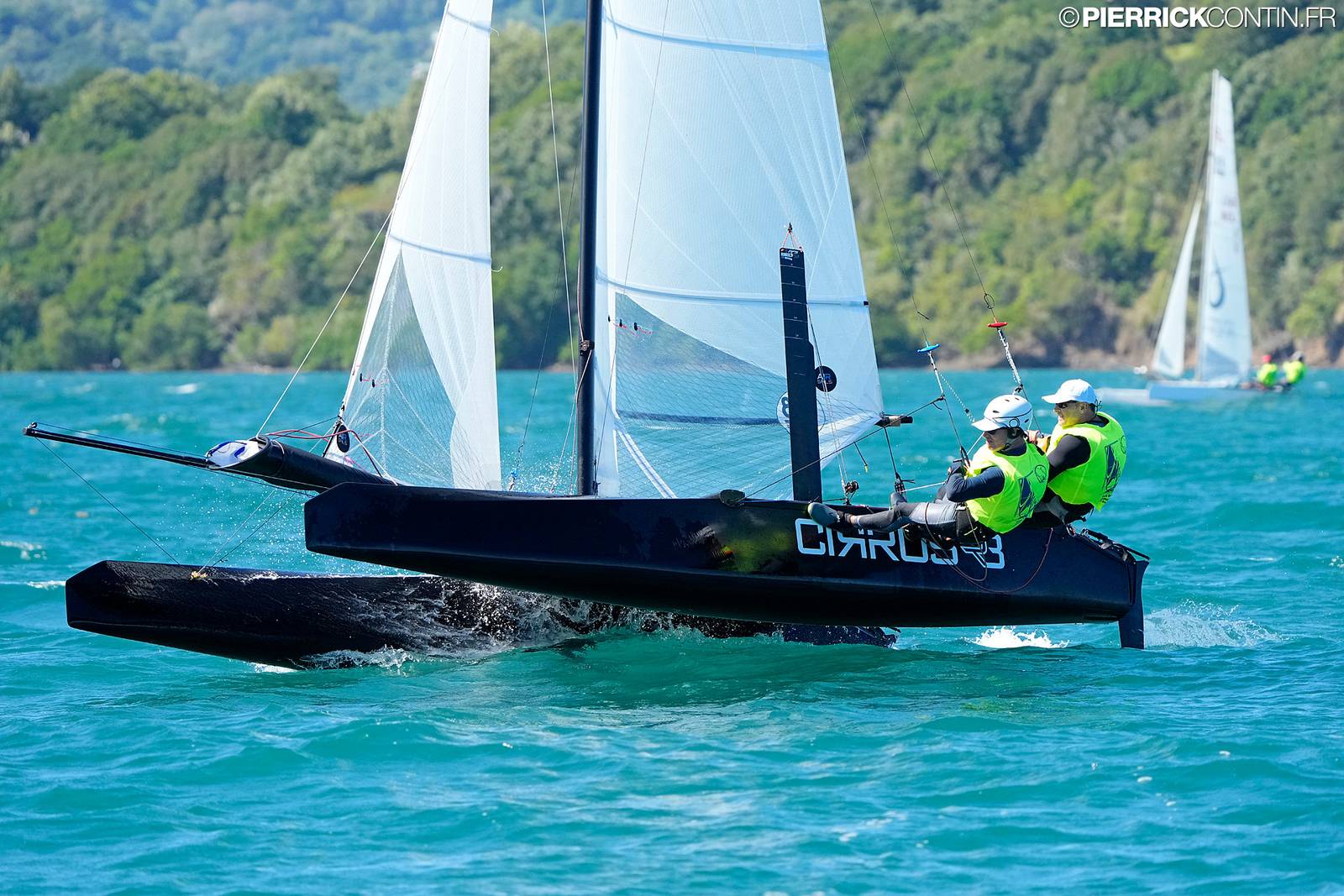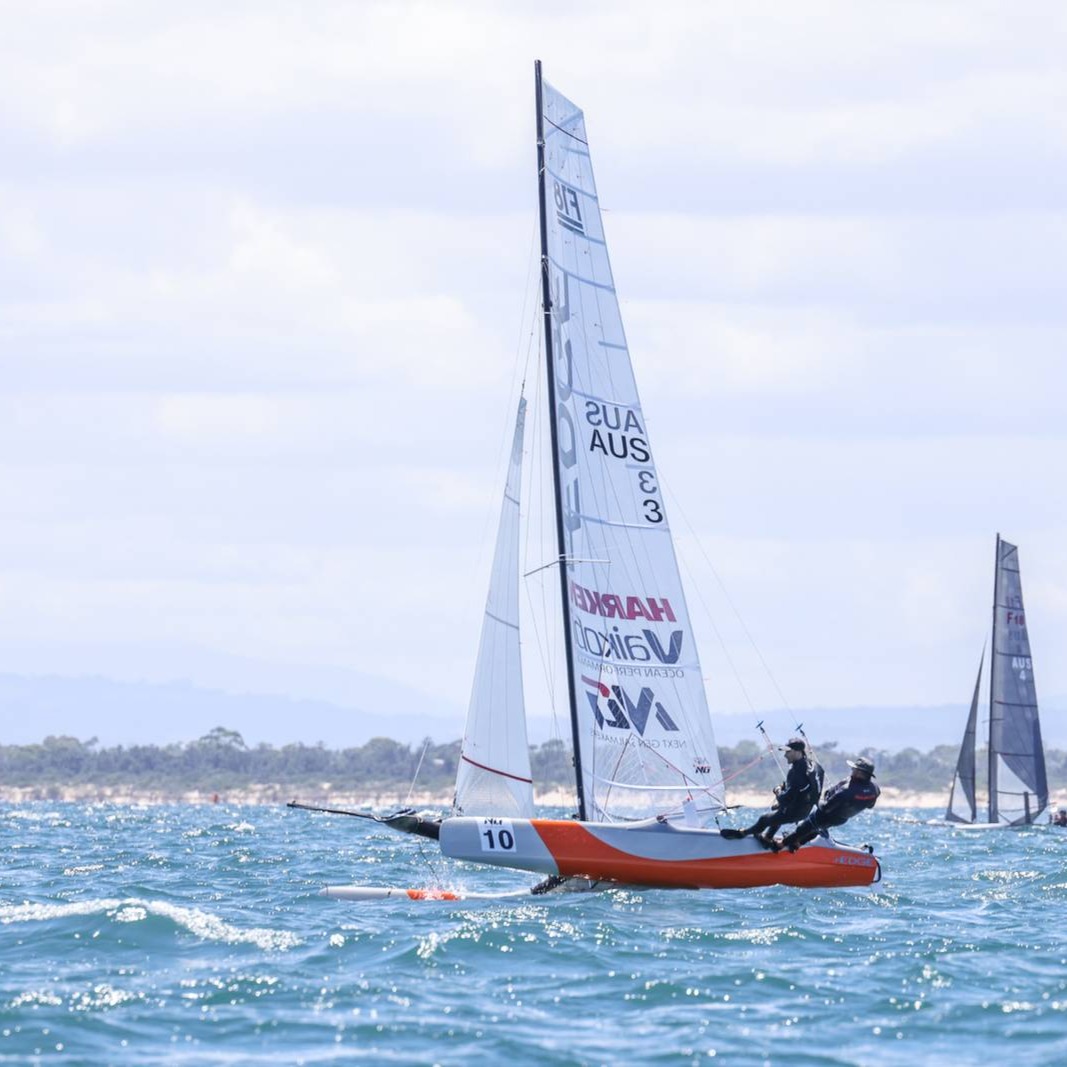A-Class: New Definition & Trial Rules for “Classics” discipline
Photo Gordon Upton: Andrew Landenberger racing Classic mode at past Worlds, where he grabbed first official Classic World Title. – Making a bit of history we can recall the A-Class start getting airborne with C Boards already, call them jumps, but no foiling whatsoever.
Later with Landy’s famous and key by now Winglets, the A-Cat gained more control and paved the way for what we have now in the Foiling Division.
Landy told me that he was getting airborne in short flights with C boards and Winglets on his
Scheurer by the time. I raced the G6 at Boardeaux 2014 and surely the platform could lift off.
Needles to speak on the Nacra 17 MKI with curved boards, we’ve seen long haul flights , and pretty stable even without rudder winglets.
This as reference of the International A-Class Association below, trying to enclose the Classic Discipline within a global definition to prevent aimed flights.
On the equipment they will restrict mainfoils to C boards with a radius limit and nothing is said on the T rudders or winglets, which is a good call cause winglets in floating mode allows you for a more safer ride in the breeze.
I experienced this also at Bordeaux 2014 with the G6 equipped with Landy’s small winglets and C boards. You couldn’t pitch pole the thing in the breeze, and it was my first time sailing As, with say 30 mins of previous sailing in BA. Thus ruling out winglets would have been a measure against better control, specially for older guys like us.
The Trial Rules basically are based on a self Rule respecting as Golf has. When playing on the Golf course you are sometimes found alone, with no one watching or enforcing you the rules book. It is your own responsibility to follow the right path in terms of fair play.
With this concept in mind IACA is transferring the non foiling responsibility to each sailor, and better you don’t get caught foiling say by 100mts or in a constant hopping or aimed small short flights trying to gain speed. If someone is caught in such attitude he/she should be banned for life.
We are talking here on clear , constant and targeted flight attitude and not the 5 boat lenghts the new trial rules puts as referential limit.
Read below official IACA’s statements, sent by Charles Bueche to be distributed and published.
IACA’s official web www.a-cat.org
———————
———————
The IACA committee has approved a trial version of the Classic Discipline rules, which will take effect for 1st March 2019 and be subject to further review at the completion of the 2019 Worlds in Weymouth. Trial rules 1 to 4 and the dispensation are self-explanatory and was the result of the work done by both the Classic Discipline Committee and the Technical Committee. As you are all aware we had tried to control the foiling aspect by a “Gentleman’s agreement” declaration signed by all competitors, which stated:
When racing in the classic discipline my boat whilst under my control will have at least one hull in the water at all times.
Unfortunately this proved a rule impossible to police and subject to conjecture. Trying to put a measurable type rule in place has proved one of immense difficulty. Our Classic Statement clearly spells out the wishes of the discipline however a well-sailed classic boat with “C” boards can foil at times and we are trying to put a restriction in place to stop this. We must do this without penalizing any boat already in existence.
A measurable Trial Rule (5) is to be put in place, which states:
A boat shall not have two hulls clear of the water for a distance of more than 5 boat lengths.
This has caused a number of issues with certain countries and members, however not one has come up with any form of viable solution other than to retain the “Gentleman’s agreement”. We cannot forget we are a World Sailing Class and all our rules must have final approval by them. We are in the fortunate position that they have allowed us a twoyear period to trial different ideas and this is all Trial Rule 5 is. This rule is not about allowing a boat to foil but acknowledging that it can inadvertently happen and if it does the skipper has a “window of opportunity” to stop it without fear of protest. 5 boat lengths is 27 meters or approximately 4 seconds at foiling pace. Similar self-policing/ measurable rules are already in existence in the Racing Rules of Sailing (Rule 42 Propulsion. Rule 18 Mark Room within a 3-boat length zone). This is not a rule allowing continual intermittent foiling.
Our sport is self-governing, and in words from our Classic Statement “Trust and Ethics” is paramount. Competitors enter the Classic Discipline based on the guidelines in the “Classic Statement” which clearly states” to enjoy fair racing in a non-foiling mode” and the principles of sportsmanship and fair play are clearly covered in Part 1 of the Racing Rules of Sailing: Rule 2 Fair Sailing. The penalties for not complying with this rule are severe.
With this updated definition, we have tried hard to keep the classics discipline an entertaining but safe platform, fun to sail and race, while still a construction class allowing for further developments. You will admit we are trying to solve a complex equation here. I’m sure everyone will play by the rules and continue to sail with us. As such, I hope to meet numerous classics sailors from all around the world in Weymouth this summer.
I take this opportunity to thank all the members of the Classic Discipline Committee and the Technical Committee which have once again worked hard for the benefit of the class !
For the IACA Committee, Charles Bueche
IACA, 26.2.2019, V1
———–
Classic Statement
The discipline is a means to continue the tradition of non-foiling A Class catamarans, which formed the basis of the great class we have today.
Its philosophy is to meet all current A Class rules with only minimal restrictions in place to eliminate the boat’s foiling ability, without limiting its open development nature.
The discipline is built on the base of trust and ethics from the competitors involved to ensure the criterion is met and for all to enjoy fair racing in a non-foiling mode.
Definition of a classic boat
1. The “classic discipline” A Class must fit all the current class rules.
2. Dagger boards are to have either a straight leading and trailing edge or be of a constant “C” curved shape with a minimum chord radius of 1190mm. All other requirements of Rule E.3 & E.4 apply.
3.The dagger board flush with the bottom of the hull and in all positions after exiting this point until fully down must fit within 780mm of the imaginary line drawn between the bottom of the hull at the leading edge of the dagger board on each hull. This measurement is to be taken parallel to boat centreplane. It shall be measured through the full range of motion (i.e. extension/retraction, cant and rake) permitted by the daggerboard case configuration and without taking into account the daggerboard deformation produced by forces expected during its normal use while racing.
4. Rudder rake adjustment whilst racing is not allowed. All other requirements of Rule E.5 (a), (b), & (c) apply.
5. A boat shall not have two hulls clear of the water for a distance of more than 5 boat lengths.
Validity and coverage of these rules
The only class rules that can be approved are in terms of the constitution, firstly needing a president’s vote to go forward and then a world ballot of all members. What IACA has approved above are “trial rules” in terms of our approval from World Sailing.
The original version of these “trial rules” – used in Hervey Bay Worlds – and remarks from officials have urged us to update these “trial rules” to remove the gentlemen agreement. Instead, we have defined (5.) above to cover the “nonfoiling” aspect of the classic discipline, in terms acceptable by World Sailing.
These new “trial rules” are valid from 1st of March 2019, and will be applied during the World Championships in Weymouth, UK. If further refinements are needed, a further look at them will take place at, or straight after Weymouth.
Dispensation
We believe the majority of classic boats will fit these proposed “trial rules” and it is not our wish to penalize any boat that holds a valid measurement certificate issued prior to the implementation date. The following dispensations will apply:
• All boats measured prior to 1st March 2019 shall comply with : “Trail Rules” 1, 4 & 5 and have daggerboards restricted to either a straight or constant curve axis. • All boats measured from 1st March 2019 shall comply with : “Trial Rules” 1, 2, 3, 4 & 5
IACA, 6.2.2019, V3





























I just heard that my great sailing friend and former CEO of Hobiecat Europe has passed. May The endless oceans…
...Report was sent by an F18 Sailor, if you want Hobies reported send your own, we'll publish as usual. Cheers.
Looks like in your report the Hobies are not really present. Suggest to rewrite the article.
Thanks for the great report Wik. Great battle.
If I correctly read the results the overall winner this year is a Hobie16